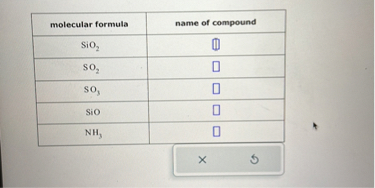
The Correct Answer and Explanation is:
Here are the correct names corresponding to the given molecular formulas:
| Molecular Formula | Name of Compound |
|---|---|
| SiO₂ | Silicon dioxide |
| SO₂ | Sulfur dioxide |
| SO₃ | Sulfur trioxide |
| SiO | Silicon monoxide |
| NH₃ | Ammonia |
Explanation:
Naming compounds relies on systematic rules, especially for covalent compounds composed of nonmetals. Let us break each down:
SiO₂ (Silicon dioxide): This is a compound of silicon and oxygen with a 1-to-2 ratio. Since both elements are nonmetals, we use Greek prefixes to indicate quantity. However, “mono” is not used on the first element, hence “silicon” followed by “dioxide.” This compound commonly occurs as quartz or sand.
SO₂ (Sulfur dioxide): Sulfur and oxygen form this molecule with a 1-to-2 ratio. Again, applying prefixes, “di-” reflects the two oxygen atoms, resulting in “sulfur dioxide.” It is widely known as a pollutant involved in acid rain.
SO₃ (Sulfur trioxide): Similar structure to SO₂ but with three oxygen atoms. The “tri-” prefix identifies this, forming “sulfur trioxide.” It reacts readily with water to form sulfuric acid.
SiO (Silicon monoxide): This compound features one silicon and one oxygen atom. “Mono-” is only used on the second element, so we get “silicon monoxide.” It is less stable compared to silicon dioxide and appears in specialized industrial processes.
NH₃ (Ammonia): This common name deviates from strict naming conventions. Ammonia contains one nitrogen and three hydrogen atoms. Although the systematic name would be “nitrogen trihydride,” “ammonia” is historically entrenched and universally recognized.
Each name reflects both structure and convention, showing how nomenclature reveals a compound’s composition and behavior.
